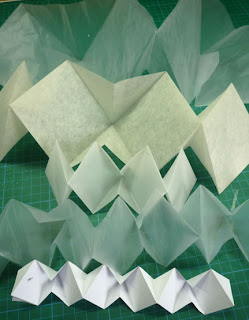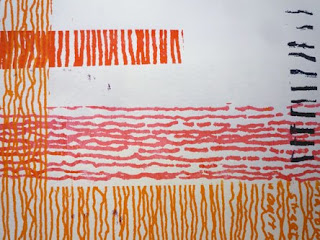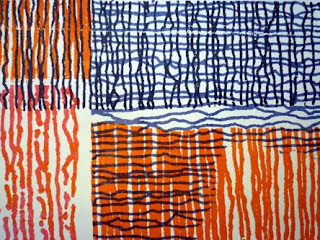 Spotted in a craft magazine in the college library - how jolly! See more work by Malka Dubrawsky at www.stitchindye.com
Spotted in a craft magazine in the college library - how jolly! See more work by Malka Dubrawsky at www.stitchindye.com
28 February 2011
Fresh quilting
 Spotted in a craft magazine in the college library - how jolly! See more work by Malka Dubrawsky at www.stitchindye.com
Spotted in a craft magazine in the college library - how jolly! See more work by Malka Dubrawsky at www.stitchindye.com
Ceramic Art London
Two terrific talks at Ceramic Art London on Sunday - the first was Paul Scott on his work, Cumbrian Blue(s) -
 and on his part in the Hanoi Mosaic Mural, which commemorates the city's 1000th anniversary - and covers 2km of grungy concrete along the highway (it's planned to extend to 6km). The mural includes Vietnamese designs -
and on his part in the Hanoi Mosaic Mural, which commemorates the city's 1000th anniversary - and covers 2km of grungy concrete along the highway (it's planned to extend to 6km). The mural includes Vietnamese designs - and work by invited international artists. Paul's design is a traditional Chinese pattern, "prunus and cracked ice" (Vietnamese ceramics were influenced by Chinese ceramics), which in the UK has become known as "Calico" and is still available. So it passed through many iterations before it arrived beside that Hanoi highway -
and work by invited international artists. Paul's design is a traditional Chinese pattern, "prunus and cracked ice" (Vietnamese ceramics were influenced by Chinese ceramics), which in the UK has become known as "Calico" and is still available. So it passed through many iterations before it arrived beside that Hanoi highway - The other talk was by Annie Turner, whose work I have long admired - she was talking about the Suffolk river and coast where she grew up and returns to often. Amid my notes are many quick scribbles
The other talk was by Annie Turner, whose work I have long admired - she was talking about the Suffolk river and coast where she grew up and returns to often. Amid my notes are many quick scribbles to remind me of the photos she showed, of meanders in the mud, planks for crossing the marsh, things sticking up in the mud -- a very evocative world -- and of the sinkers, spoons, sluices, ladders she has made that embody this landscape and history.
to remind me of the photos she showed, of meanders in the mud, planks for crossing the marsh, things sticking up in the mud -- a very evocative world -- and of the sinkers, spoons, sluices, ladders she has made that embody this landscape and history.Among the RCA ceramics students' work were these "sweater birds" by Katy Jennings
 In the main show, I loved the animals - and especially the birds - by Susan O'Byrne -
In the main show, I loved the animals - and especially the birds - by Susan O'Byrne -
 the colours in the work of Elke Sada -
the colours in the work of Elke Sada -
 and Carol Farrow's recent works in paper clay -
and Carol Farrow's recent works in paper clay -
 But what came home with me was a tea caddy by Robert Cooper -
But what came home with me was a tea caddy by Robert Cooper -
 It sits between the storage jar, from Holmfirth days (mid-70s) and the vase by Maggie Byrne, my first purchase at a Chelsea Craft Fair (mid-80s).
It sits between the storage jar, from Holmfirth days (mid-70s) and the vase by Maggie Byrne, my first purchase at a Chelsea Craft Fair (mid-80s).
 In the main show, I loved the animals - and especially the birds - by Susan O'Byrne -
In the main show, I loved the animals - and especially the birds - by Susan O'Byrne - the colours in the work of Elke Sada -
the colours in the work of Elke Sada - and Carol Farrow's recent works in paper clay -
and Carol Farrow's recent works in paper clay - But what came home with me was a tea caddy by Robert Cooper -
But what came home with me was a tea caddy by Robert Cooper - It sits between the storage jar, from Holmfirth days (mid-70s) and the vase by Maggie Byrne, my first purchase at a Chelsea Craft Fair (mid-80s).
It sits between the storage jar, from Holmfirth days (mid-70s) and the vase by Maggie Byrne, my first purchase at a Chelsea Craft Fair (mid-80s).Book du jour
 Yesterday evening, unpacking some purchases, I liked the sound the plastic bag made and laid it on the workbench, to be made into a book this morning - a book that revealed this sonic quality. After working out the structure (front), I made a larger (rear) and smaller version - and also versions from tracing paper (middle) and, above that, teabag paper. They all sound different.
Yesterday evening, unpacking some purchases, I liked the sound the plastic bag made and laid it on the workbench, to be made into a book this morning - a book that revealed this sonic quality. After working out the structure (front), I made a larger (rear) and smaller version - and also versions from tracing paper (middle) and, above that, teabag paper. They all sound different.While working - and listening to the rustles and crinkles that wer happening as the paper rubbed up against itself - I was thinking of "sounds to read by" and how white noise can be used to mask tinnitus. One of the highlights of a trip to Helsinki in 2003 was the soundscape in the Academic Bookstore - it was subtle and had to be pointed out to me ... sounds of a pen scratching, someone coughing, pages turning - very appropriate! Since then, I've not been able to bear the stupid music that plays mindlessly in the big bookstores. (Or the raucous conversations of staff in smaller, non-music-playing shops ... but that will be another rant, another time...)
27 February 2011
Book du jour
Art I'd like to see more of - Jennifer Bowes
 Jennifer Bowes (who lives in British Columbia) makes collograph plates that are constructed by repetitively winding and tying small units of materials until they form a densely woven surface from which she is able to print a near-photographic impression of the textured mass of material. (She's showing at Malaspina Printmakers on Granville Island, Vancouver, till 11 April, along with Denise Hawrysio, Jessica Jackson Hutchins, Niall McClelland, and Joyce Wieland.)
Jennifer Bowes (who lives in British Columbia) makes collograph plates that are constructed by repetitively winding and tying small units of materials until they form a densely woven surface from which she is able to print a near-photographic impression of the textured mass of material. (She's showing at Malaspina Printmakers on Granville Island, Vancouver, till 11 April, along with Denise Hawrysio, Jessica Jackson Hutchins, Niall McClelland, and Joyce Wieland.)"Woven Knots" (detail above; see some other works here) is one such. “Suspended” is slightly different: at first it appears to be an enormous knitted garment, but it's made of thousands of strips of shredded text - ten books cut and reconfigured, it "remains in contention between the arbitrary contexts of texture and craft art."
I'd love to see "Dream of Scipio", which she made for her MFA show and is described as "a book of over 100 pages where each line of text was double stitched in white thread rendering it illegible. Taking over 600 hours to complete, the book becomes heavily texturized, proposing an aerial view point if not a tactile one, re-inscribing the act of reading and interpretating with our hands more than our minds. The sense of touch triggers points of memory, prompting another entry point into the text beyond the hermeneutical. Bowes sees her work as a colloboration with the writer, imposing a silence to the words that can now be accessed haptically. "
"With slight variation, each seemingly repetitive motion--whether in knotting, knitting, or carving--is in fact a new point of connection. Bowes references her method of working as influenced from the motions in walking and hiking, a perpetual repetition and rhythm of breathing."
26 February 2011
Korean artists in London
60 Korean artists who now live in London are exhibiting (24-27 Feb) at the Bargehouse and Oxo Gallery - their fourth annual exhibiton (see www.4482.info) -
 At the opening, Lisa and I were enjoying the venue along with the art -
At the opening, Lisa and I were enjoying the venue along with the art - There are a few renovated rooms, but mostly the Bargehouse is a palimpsest -
There are a few renovated rooms, but mostly the Bargehouse is a palimpsest -
and a place that lends itself to improvisation -
 Work by Haeree Cho, made of strings from musical instruments -
Work by Haeree Cho, made of strings from musical instruments - Simply, and rather beautifully, nails in a dozen long bits of wood, leaning against a wall, by YoonJung Kim -
Simply, and rather beautifully, nails in a dozen long bits of wood, leaning against a wall, by YoonJung Kim - Lines! wavy lines - "626" by Yoonsuk Choi -
Lines! wavy lines - "626" by Yoonsuk Choi - And just as we were leaving, Hyemin Park's "Selfridge-Primark" - it features product images she found in Selfridges and in Primark, drawn onto canvas; the artworks are offered for sale at the same price as the object that's been drawn. A drawing of a skirt from Selfridges might be £315, a shirt from Primark £6 - original artworks at product prices. This is part of her larger product about commercial value and its relation to labour, and of the different ways the artist can interact with her audience.
And just as we were leaving, Hyemin Park's "Selfridge-Primark" - it features product images she found in Selfridges and in Primark, drawn onto canvas; the artworks are offered for sale at the same price as the object that's been drawn. A drawing of a skirt from Selfridges might be £315, a shirt from Primark £6 - original artworks at product prices. This is part of her larger product about commercial value and its relation to labour, and of the different ways the artist can interact with her audience. She had the relevant bags for the work, and sold me a nice pair of shoes - from Primark.
She had the relevant bags for the work, and sold me a nice pair of shoes - from Primark.

This week at college - happenstance and lecture
 Intrigued by the blank pages in Elica's book of "love poems", which she has blanked out and is re-writing, I couldn't help noticing similar configurations in a magazine (I-D, perhaps?) in the library -
Intrigued by the blank pages in Elica's book of "love poems", which she has blanked out and is re-writing, I couldn't help noticing similar configurations in a magazine (I-D, perhaps?) in the library -

Back in the basement studio -

During discussion of projects, my "tube book" got stretched out to its full length ... no wonder it took so long to put together! And to think it folds up into a (large) matchbox.
This week's lecturer, Caroline Bergvall, has a multilingual practice and uses text as an installation piece - this is part of Middling English, Language - Space - Sound (also described here) -

She quoted Robert Smithson as saying language is built, not written, and also mentioned Gordon Matta Clark's Conical Intersect (he's in the current show at the Barbican Gallery). There was much of interest in her talk - can it be summed up in a few phrases? - multiple languages (of origin); multiple spaces of inscription; body representation - and its signals; exploration of ephemerality; the audience's assumption of (the author's) presence; operating across literary knowledge; crossing, traversing, translating borders; shibboleths; ideological concerns in etymology; the physicality of handwriting; ballads reclaiming a forgotten pool of culture; text in space - a trajectory, a metaphor ... no, it can't be summed up in a few phrases...
This week at college - seminar
Denise Hawrysio told us about her work and brought along some of her beautifully-made books, including a silver and gold duo in which the interaction of glue and paper is causing chemical changes -
 A large volume containing sections of a drawing that once stretched right round a room -
A large volume containing sections of a drawing that once stretched right round a room - One of the four "Killing" books (the mink), made from fur coats found in thrift shops (the rabbit is in the V&A) -
One of the four "Killing" books (the mink), made from fur coats found in thrift shops (the rabbit is in the V&A) - "The Spotlight Project" has developed over a decade, starting with a catalogue of actors, from which she cut the faces. Video, photographs, prints, and site-specific installations have resulted -
"The Spotlight Project" has developed over a decade, starting with a catalogue of actors, from which she cut the faces. Video, photographs, prints, and site-specific installations have resulted -
Over the years Denise has worked in film, video and installation, as well as printmaking. One project, "Red Period Blue Period", consisted of making 120 books, and giving them to prisoners to use for one month; they were exhibited in Aalst, Belgium in 1994:

She mentioned Anthony McCall's film works (especially Line Describing A Cone) and A L Rees as influences during her film studies, and the wonderful presentation of her work is due to a bookbinding course with "the masters" of traditional technique at London College of Printing.
Looking at her website, I'm intrigued how her "situational prints" integrate conceptualised practices into printmaking - she "produces her prints by employing external agents: human and physical (such as cars driving over etching plates). The prints are a collaboration between the artist and the world as she finds it; the actions and motions of Hawrysio's surroundings leave their mark on her art, with the result that each print is a still, a frozen interface between the materials of art and the physicality of the world." As written in the catalogue to the exhibition, "life takes on richness according to its ability to record its own actions". (There seems to be a lot of that reflexivity around at the moment - art that embodies the record of its making.) Her use of "diagrammatic and cartographical possibilities", and "quasi-rational repetitions and palimpsestic layering," also resonate. "The Situationist idea of the construction of the event" and "the Dadaist project of returning the everyday to art" might be relevant to where my own project is going (or coming from).
Textile printing - twice this week again
After last week's red and yellow printing, Wednesday's session used orange, starting new papers and adding to the blank spaces on others -
 Here it all is in progress -
Here it all is in progress - On Thursday a lovely blue was available among the premixed colours (leftovers), and also several purples -
On Thursday a lovely blue was available among the premixed colours (leftovers), and also several purples - The backing sheets are building up their random colours -
The backing sheets are building up their random colours -
 Some closeups -
Some closeups -


 I'm still adding to already-printed bits of fabric -
I'm still adding to already-printed bits of fabric - Suddenly I have a system - and having a system makes me happy! The system involves randomness and accident/serendipity: using the available colours, and placing the screen not quite randomly, but without agonising. And - nothing is wasted. The work evolves, it accumulates.
Suddenly I have a system - and having a system makes me happy! The system involves randomness and accident/serendipity: using the available colours, and placing the screen not quite randomly, but without agonising. And - nothing is wasted. The work evolves, it accumulates. There are rules - but they too evolve:
1. take colours from the leftover pots - they can be mixed, and the pots need not (but preferably are) be empty at the end of the session
2. more than one paper can be printed at once (but not more than three at a time)
3. not all backing sheets need to have every colour - start new sheets every session, and from now on, use each new colour only on one side of the already-printed backing sheets
4. leave white space
5. enjoy overlap
6. don't plan ahead
Subscribe to:
Posts (Atom)



 Here they are (bits of nonsense really) -
Here they are (bits of nonsense really) -


